New updates are available in MyCourses! See below for details, and please contact helpdesk@ggc.edu if you encounter any problems or have questions.
MyCourses
Assignments – Flexible text or file submission options for enhanced student choice | New
This feature enables instructors to create a new assignment type that accepts submissions in the form of an uploaded file, text entered in HTML Editor, or both.
To create this new type of assignment, instructors must go to the New Assignment page, expand the Submission & Completion panel, open the Submission Type dropdown, and select the new File or text submission option.
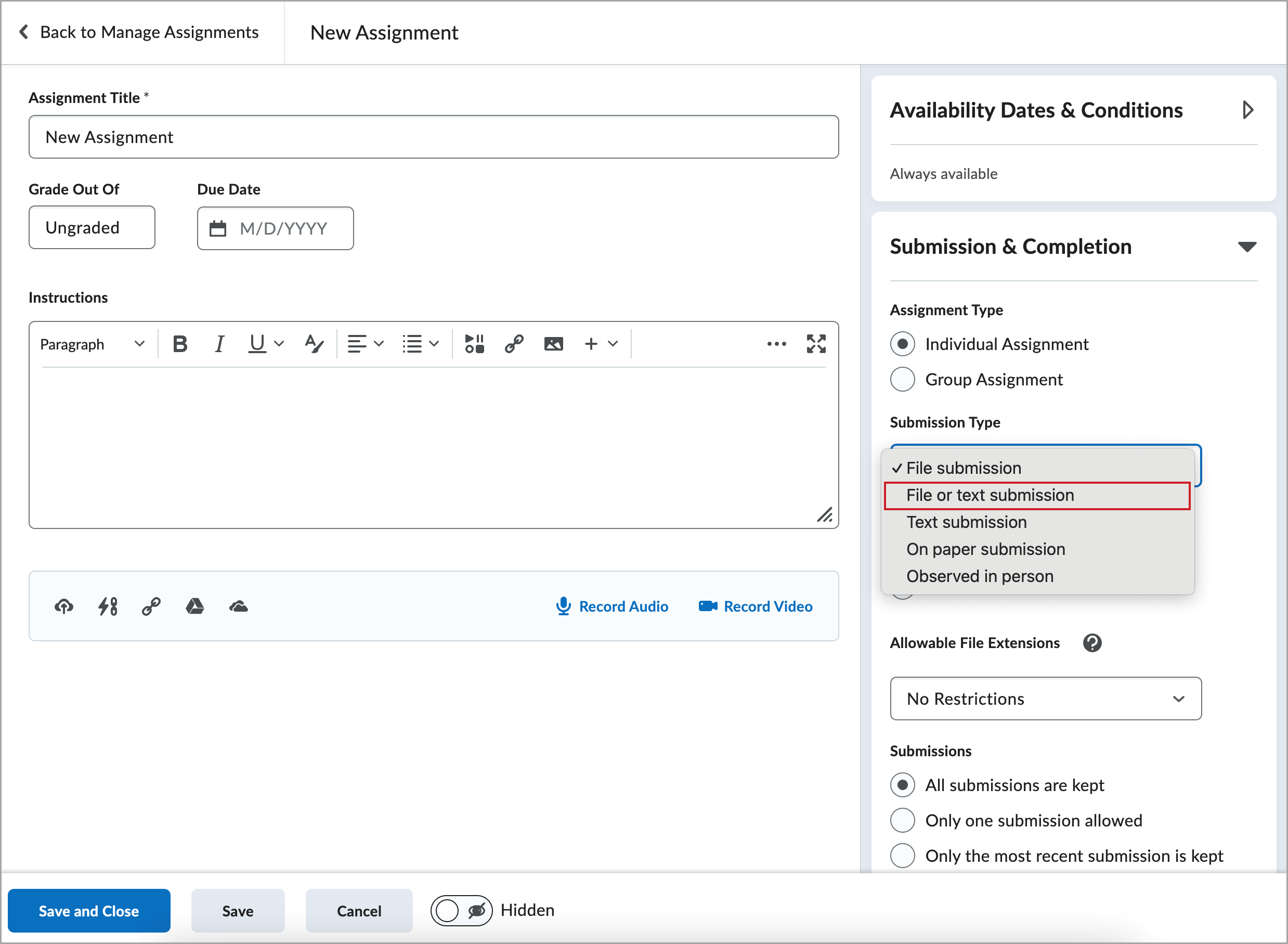
For these assignments, students can choose how they want to demonstrate their learning. For example, if the assignment is an essay, students can upload a file, paste a link to an external file in the text box, or type the entire essay into the text box. For assignments restricted to only one file, students still have the option to add a text submission. Students will also see an expanded HTML Editor for text submissions on the assignment submission page.
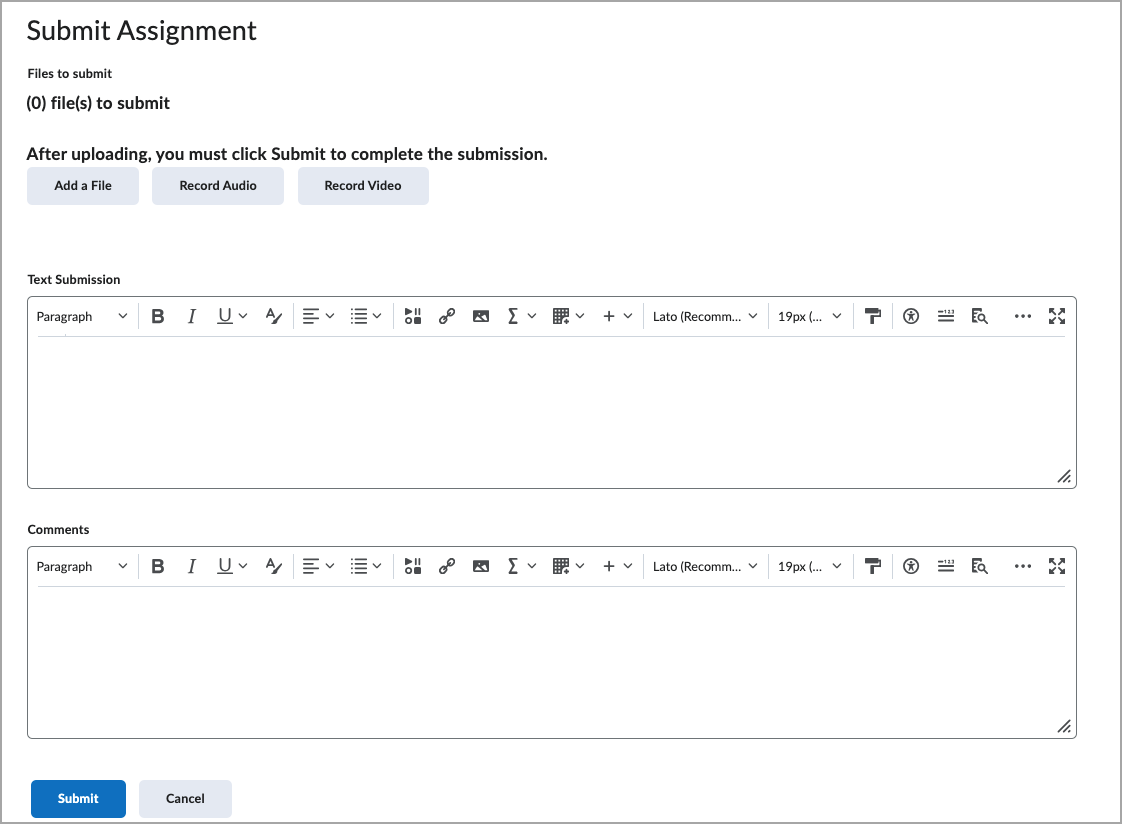
Previously, the available Submission Types were: File submission, Text submission, On paper submission, and Observed in person.
Assignments and Discussions – Bulk feedback for instructors transitioning to default, with opt-out until October 2025 | Updated
This feature was originally released in April 2025, and it enables instructors to provide bulk feedback to students directly within the Assignments and Discussions submission pages, streamlining their feedback workflows.
The feature is now ON by default.
Groups – All group enrollments now processed via background job | New
To support upcoming changes to increase group enrollment limits planned for August 2025, all group enrollment workflows are now consistently handled by a background job.
Previously, group enrollments created through the Groups tool, APIs, and course copy operations were processed asynchronously to reduce timeouts and errors. With this update, all group enrollment methods (through the Manage Users tool, Classlist enrollments that add users to groups, enrollment APIs, Banner integrations, and Self Registration) are processed using the same background job mechanism.
For end users, this update ensures that when they complete an enrollment in a course offering, any corresponding group enrollments within that course are also processed automatically. This background process may take one to two minutes to complete.
This feature provides consistent and efficient group enrollments across tools and workflows, ensuring a seamless experience as enrollment limits increase, and preventing timeouts and errors during high-volume events.
For more information about planned enrollment changes, refer to the Improving groups with increased enrollment limits blog post.
Groups – Bulk enroll and unenroll users by CSV file import | New
Instructors can now bulk enroll or unenroll students in existing groups using a comma-separated values (CSV) file in the Groups tool. This feature adds a new Import button to the Manage Groups page and an Import option in the Category drop-down menu. Clicking Import opens a guided workflow with detailed instructions for correctly formatting the CSV file. Each line in the file must represent a single action: either enrolling or unenrolling a student from a specific group in the course. CSV file modifications are limited to students currently enrolled in the course.
Once uploaded, the system validates the CSV file. If the file contains no errors, the enroll or unenroll actions are performed, and once completed, the import results are displayed immediately. If there are any errors found in the file, the process stops and generates a list of errors found.
Cancelling the process does not reverse completed actions. Only one import process can run at a time.
Administrators can configure the CSV file format in the Form Elements tool using the new form element BulkGroupEnroll. The following form element properties are customizable:
- Username
- Org Defined Id
- Group Name
- Group Code
Either Username or Org Defined Id, and Group Name or Group Code, are required to ensure there is enough information to complete the enrollment or unenrollment action.
The new workflow is available to roles with the Groups and Sections Management > Create/Edit/Delete Groups and Categories permission enabled.

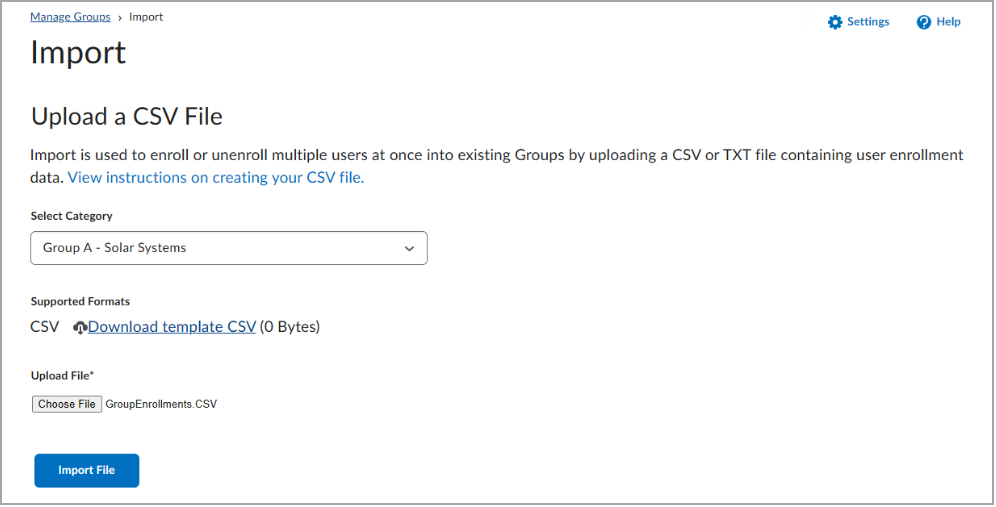
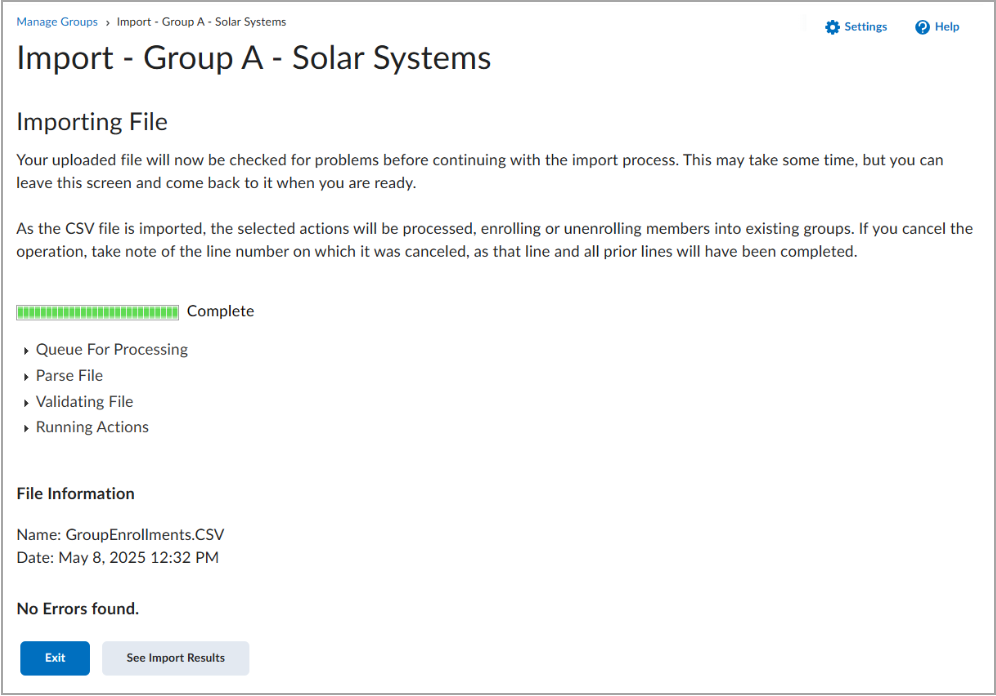
New Content Experience – Add and access content at any level of depth | New
Users can now add and access content at unlimited levels of depth in the New Content Experience. This enhancement preserves the original course structure created in Classic Content or another LMS and improves efficiency by eliminating the previous five levels restriction. With this update, there is no longer a need to reorganize deeply nested content. The new functionality includes:
- The original content hierarchy or structure is maintained.
- Users can drag and drop content regardless of its depth.
- Current New Content Experience users can now create content at deeper levels.
Previously, content deeper than five levels in Classic Content or another LMS was hidden in the New Content Experience, requiring course restructuring before enablement.
New Content Experience – Display existing course Overview content | Updated
Instructors and students can now view the course Overview when enabling the New Content Experience. This update enhances user experience and efficiency by preserving the Overview created in Classic Content. The following updates are included:
- Users with an Overview in Classic Content will see the same text/files in the New Content Experience.
- The Overview now appears visually as the first module in a course
- Users can delete the Overview, which will also be deleted in Classic.
- Users can edit the Overview, and the changes will be reflected in Classic.
- Users who have not added any text/files to the Overview in Classic will not see this module in the New Content Experience.
- The course Overview cannot currently be added directly from the New Content Experience.

Previously, the course Overview added in Classic Content was not displayed in the New Content Experience.
New Content Experience – Display student completion progress | Updated
Students can now track the completion of content topics within a module by viewing a progress indicator next to each topic in the New Content Experience. This feature brings several improvements to help students easily identify remaining topics in a module. The updates are as follows:
- Check marks for completed items.
- Fractional summary of the student’s progress for each content module.
- Due dates are now displayed on a single line, with a tooltip appearing on hover for additional details.
Note: If due dates are not set by the instructor, availability dates will be shown instead.
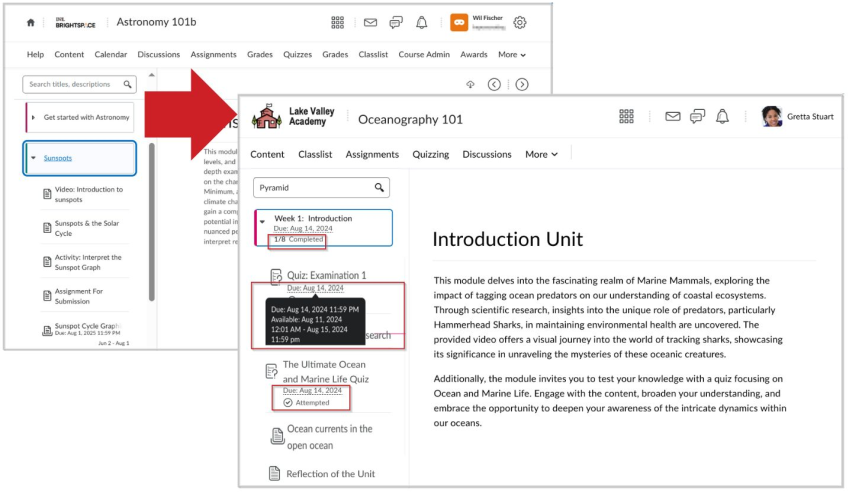
Previously, content completion progress was only available in Classic Content.
Quizzes – New Quiz Evaluation Experience is the default | Updated
Initially introduced in September 2024, the New Quiz Evaluation Experience is now enabled by default for all clients.
As a result, the legacy quiz evaluation experience is no longer available when grading by Users or Attempts. The Grade by Questions workflow remains unchanged.
Quizzes – Full HTML Editor for Question Feedback | New
This update introduces the full HTML editor for question-level feedback in Quizzes, enhancing the instructor experience and aligning it with the editors already available for Attempt Feedback and Overall Feedback, including support for the equation editor and file upload features.
Previously, instructors could provide feedback on individual questions using only the inline HTML editor, which offered limited formatting and functionality. With this update, instructors can now:
- Upload files securely
- Insert equations
- Use advanced formatting and media tools

Quizzes – Reopen a submitted quiz attempt | New
Instructors can now reopen the most recently submitted quiz attempt, allowing students to resume from where they left off. The new feature supports scenarios where students run out of time or submit their attempt by mistake, reducing frustration from auto-submissions and improving overall quiz management flexibility.
Previously, instructors could not reopen a submitted quiz attempt. This update introduces the ability to return quiz attempts to an unsubmitted state and adjust time limits if needed.
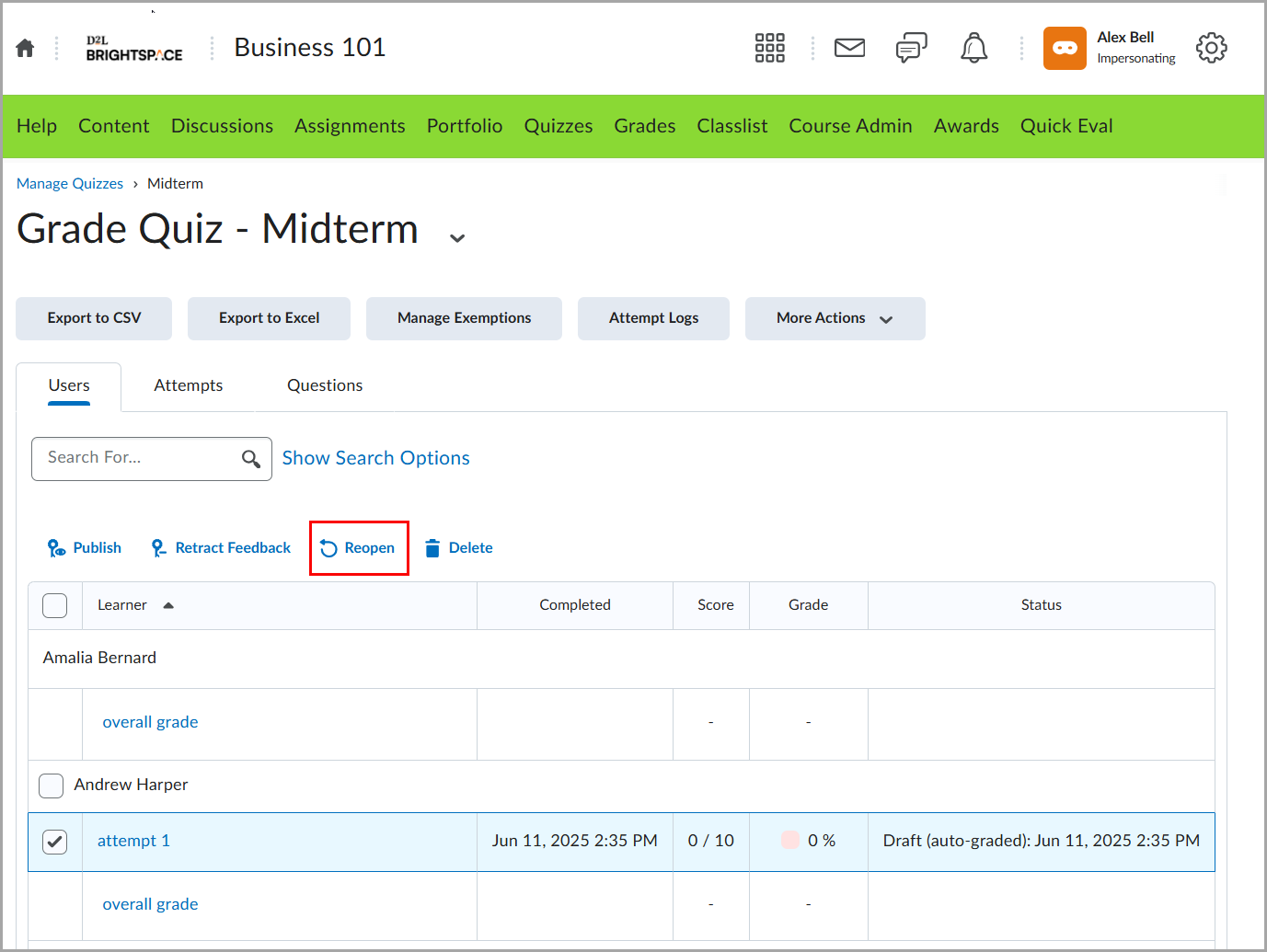

Quizzes – Statistics available for rubrics on written response questions | New
Instructors can now view rubric statistics for rubrics associated with written response questions across all students’ first attempts in a quiz. Both Overall Statistics and Criteria Statistics are included with this update.
Previously, rubric statistics were limited or inconsistent for written response questions. With this update, the rubric statistics display data per quiz question for all users, not just the quiz overall.
The user interface clearly indicates that only first attempts with text are included in the stats.
This update provides instructors with consistent rubric statistics across all assessment types for better insight into how students perform on written response questions in particular.
Rubrics – Options to improve rubric management | New
To improve efficiency when reviewing assessments, instructors can now clear rubric scoring using the new Clear Selections option.
This update supports instructors who need to reset scoring and start from scratch. Clearing the rubric score does not remove any previously entered feedback.
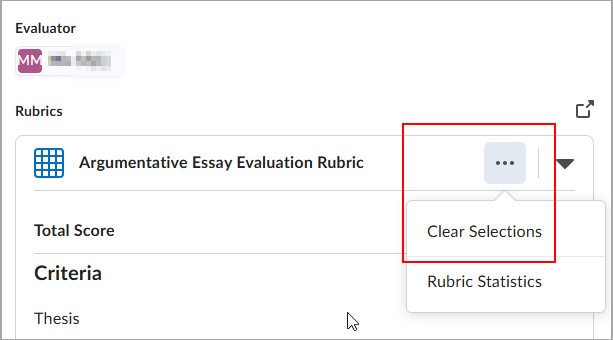
Selecting Clear Selections requires users to confirm the action. The option to undo this action appears in a pop-up window for a brief amount of time after clicking Clear Selections.
Previously, to modify scoring, instructors had to manually clear each rubric level.
In addition to the Clear Selections menu option, the Set All Ungraded option is also updated. When no rubric levels are selected, the option now appears as Set All to Yes and Set All to No in the menu.
This improvement follows the recent release of the Set Ungraded option in the January 2025/20.25.01 release, to make it easier to manage rubric scoring.
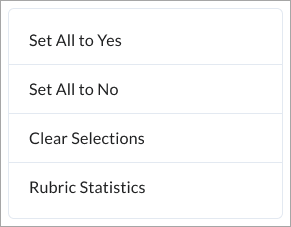
Turnitin
On August 5, Turnitin AI writing scores will be available in the Assignments dropbox. Instructors will be able to view AI writing scores directly in the dropbox without opening individual reports.
AI writing scores will remain hidden from students. Instructors can share the AI reports with students at their discretion.
Need to learn more?
Need to learn more about MyCourses, Zoom, Accessibility, or Classroom Technology?
Check the IT Webinar Schedule – OR- Schedule a 1-1 Consultation
